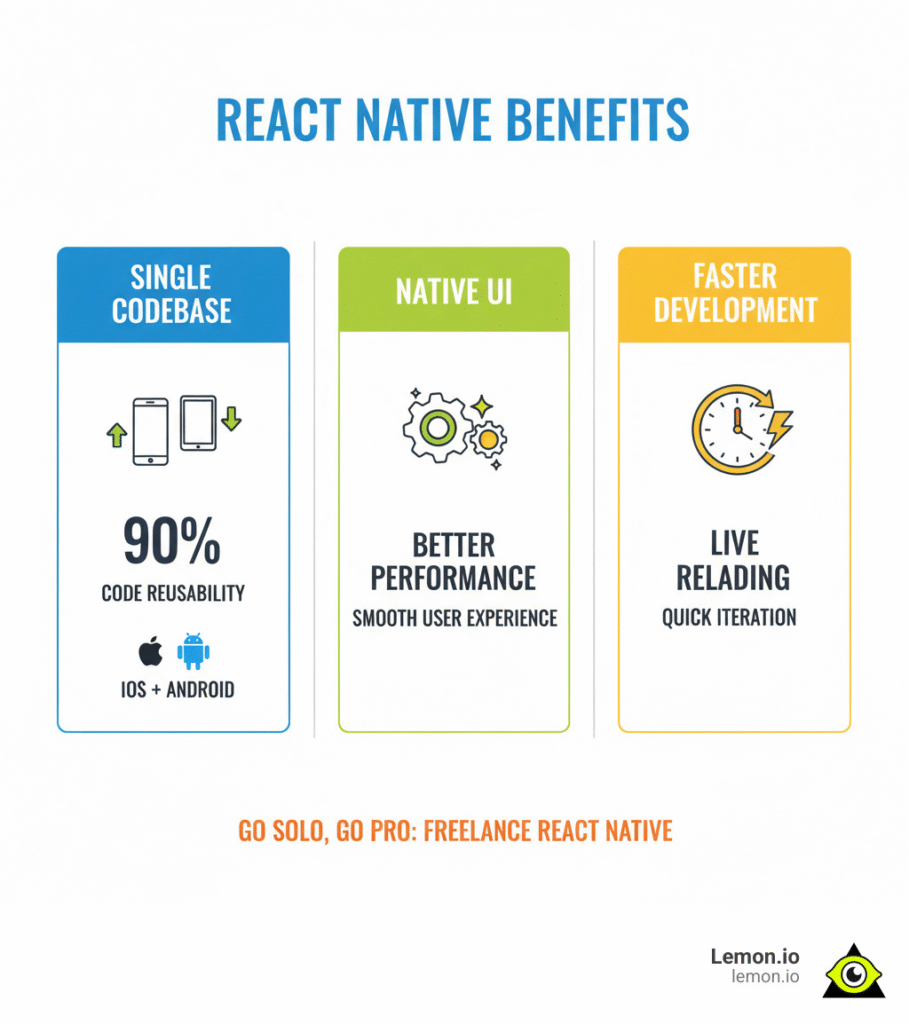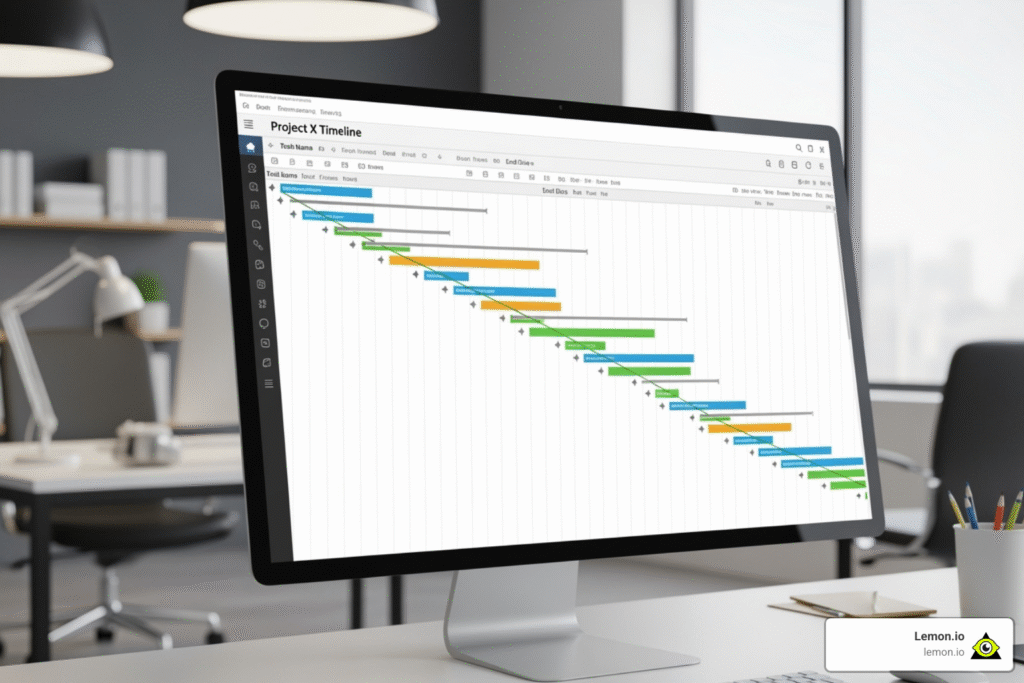To hire freelance react native developers, focus on three advantages: access to global talent, significant cost savings (up to 58%), and team flexibility. React Native’s 90% code reuse across iOS and Android makes it perfect for startups aiming to launch cross-platform apps quickly.
Quick Answer for Hiring Freelance React Native Developers:
- Where to find them: Vetted talent platforms and specialized developer communities
- Cost range: Hourly rates vary, with premium talent typically costing $60-$100+ per hour
- Timeline: Hire in as little as 72 hours; average project completion is 1-17 days
- Key skills: JavaScript/ES6, React.js, cross-platform development, API integration
- Hiring models: Hourly, project-based, part-time, or contract-to-hire
React Native powers over 40% of mobile apps, including those from Facebook, Instagram, and UberEats. For growing companies, combining React Native’s efficiency with freelance flexibility is a powerful strategy for rapid app development. The key is knowing how to hire effectively to tap into the top tier of global talent without the overhead of full-time employees.
I’m Aleksandr Volodarsky, and I’ve helped scale lemon.io from $2.7M to $10M by connecting companies with top freelance developers. Through this experience, I’ve learned exactly what works when you hire freelance react native developers and what pitfalls to avoid.

Why Choose React Native and a Freelance Developer?
Deciding how to build your mobile app can be a puzzle. This section will show why React Native is a stellar choice and why choosing to hire freelance React Native developers is a smart, strategic move.

What is React Native?
Born from a Facebook hackathon, React Native is an open-source framework for building native mobile apps with JavaScript and React. It translates your code into native iOS and Android UI components, so your app looks and feels native, providing a seamless user experience.
The main advantage is cross-platform development. Instead of building two separate apps, you write a single codebase that works on both platforms. With about 90% of the code being reusable, this dramatically cuts development time and costs. Because React Native uses actual native UI components, your app delivers an authentic user experience with top-notch performance. For teams familiar with JavaScript, the learning curve is shallow compared to learning native languages.
Curious about more? Dive deeper into What is React Native Used For?
The Freelancer Advantage: Flexibility, Cost, and Expertise
React Native is powerful, but who will build your app? This is where the freelance advantage shines.
Here’s why hiring a freelancer is a game-changer:
- Cost Savings: Hiring a full-time employee involves salaries, benefits, and recruitment fees. Freelancers charge for the work done, potentially saving you up to 58% and eliminating direct hiring costs of around $4000 per recruit.
- Global Talent Pool: You’re not limited by geography. You can access highly skilled developers from regions with more competitive rates, like Eastern Europe or Latin America ($75-$95/hr), without sacrificing quality.
- Niche Skills on Demand: Need an expert in a specific library or industry? Freelancers allow you to bring in precise expertise exactly when you need it.
- Project Flexibility: Easily scale your team up or down for short-term projects, feature builds, or ongoing maintenance without the commitment of employment contracts.
- Faster Onboarding: Platforms like Lemon.io can help you find and onboard top talent in days, not months. Some freelancers can be hired in as little as 72 hours.
- Reduced Overhead: Forget HR paperwork, payroll taxes, and benefits management. Freelancers handle their own administration, letting you focus on your core business.
Ready to explore how a freelance model can boost your mobile development? Learn more about Hire Mobile App Developers.
Freelancer vs. Full-Time Employee
For specialized roles like a React Native developer, the freelance model offers distinct advantages over a full-time hire. Here’s a breakdown of the key differences:
Feature |
Freelancer |
Full-Time Employee |
|---|---|---|
Cost |
Project-based or hourly rates; no benefits, taxes, or overhead. Potential for up to 58% savings. |
Salary, benefits, taxes, office space, equipment, training. Higher overall cost. |
Hiring Speed |
Rapid onboarding (days to weeks); often as fast as 72 hours to hire. |
Lengthy recruitment process (typically weeks to months). |
Commitment Level |
Project-specific or flexible contract; short-term or long-term based on need. |
Long-term commitment; integral part of company culture and growth. |
Management Overhead |
Self-managed; less administrative burden and HR responsibility for you. |
Requires ongoing management, HR support, and performance reviews. |
Flexibility |
Scale up/down as needed; access to diverse skills globally. |
Fixed capacity; scaling can be slow and often costly. |
Expertise |
Niche specialists available globally, often highly experienced in specific areas. |
Generalists or specialists within your local hiring pool, potentially requiring training. |
The Ultimate Guide to Hire Freelance React Native Developers
You’re sold on React Native and the freelance model. Now, how do you find the right developer? This guide will walk you through the process.

Step 1: Defining Your Project and Required Skills
Before you post a job, get clear on what you need. Define your project scope: are you building an MVP or a full-featured app? Outline the core features, target audience, and business goals. The clearer you are, the better a freelance React Native developer can estimate the work.
Next, list the essential technical skills:
- JavaScript/ES6+: The foundation of React Native.
- React.js fundamentals: Understanding of components, props, state, and lifecycle methods.
- State management: Experience with libraries like Redux, MobX, or the Context API.
- API integration: Proficiency with REST APIs or GraphQL using tools like Axios or Fetch.
- Native modules & libraries: Ability to integrate and troubleshoot third-party libraries.
- Debugging & testing: Skills in finding bugs and writing automated tests with Jest or Mocha.
- Version control: Proficiency with Git.
Don’t forget soft skills, which are crucial for remote collaboration:
- Communication: Clear, proactive, and able to explain technical concepts simply.
- Problem-solving: Critical thinking to overcome development challenges.
- Time management: Discipline to work independently and meet deadlines.
Defining these requirements will help you write a compelling job description and filter candidates effectively. If your project involves specific command-line interface tools, you might also want to look for React Native CLI Developers.
Step 2: Where and How to Find Top Talent
With your requirements defined, it’s time to find your developer. Focus on quality over quantity.
Vetted talent platforms are an excellent starting point. Platforms like ours rigorously screen developers, giving you access to the top 1-3% of talent. Our manual vetting process includes technical and behavioral assessments, saving you time and ensuring a high caliber of candidates.
Also, explore niche communities like Reddit’s r/reactnative or browse GitHub to see developers’ open-source contributions. A thorough portfolio review is essential. Look for past React Native projects, check live apps on app stores, and review code samples for quality if possible. Finally, checking references with previous clients can provide invaluable insight into a developer’s reliability and work ethic.
Step 3: The Vetting Process: Questions to Ask Your Freelance React Native Candidate
The interview is your chance to dive deep. Ask targeted technical questions to gauge their React Native expertise.
- Core Concepts: “How do you handle platform-specific code in React Native?” or “Explain the difference between how React and React Native render UI.” (For more, see our guide on React Native Platform Specific Code).
- State Management: “Describe your preferred state management solution for a complex app (e.g., Redux, Context API) and why.”
- Performance: “What are common performance bottlenecks in React Native, and how do you optimize for them?” (Look for answers mentioning FlatList, PureComponent, etc.).
- Debugging: “What tools and techniques do you use to debug a crashing React Native app?”
- Native Integration: “When would you decide to write a custom native module instead of using a JavaScript-based solution?”
These questions will help you assess their practical experience and problem-solving skills, ensuring you hire a capable freelance React Native developer.
Step 4: Ensuring Quality and a Smooth Collaboration
Hiring is just the start. Establish clear processes to ensure a smooth project.
- Clear Contracts: Define the scope of work, deliverables, deadlines, payment terms, and IP ownership.
- Non-Disclosure Agreement (NDA): Always get an NDA signed before sharing sensitive project details to protect your intellectual property.
- Milestone Payments: Break payments into smaller milestones tied to completed work. This reduces risk and provides natural check-in points.
- Project Management Tools: Use tools like Jira, Trello, or Asana to track tasks and keep communication organized.
- Regular Communication: Schedule daily or weekly check-ins to stay aligned and resolve issues quickly.
- Code Reviews: Have another developer review the freelancer’s code to ensure quality and consistency.
Setting up these safeguards creates an environment for success.
Understanding Costs, Timelines, and Hiring Models
Let’s talk money and time. Understanding the financial landscape and project timelines is crucial when you hire freelance React Native developers.

How much does it cost to hire a freelance React Native developer?
React Native developer costs vary, which offers budget flexibility. Hourly rates are most common and depend on experience and location. For vetted, premium talent, rates typically fall between $60-$100+ per hour.
Geography is a major factor. A senior developer in Silicon Valley might cost $150+/hour, while equally skilled developers from Eastern Europe or Latin America often charge $75-$95/hour. This allows you to tap into global talent pools where your budget goes further.
Experience also creates price tiers: junior developers are more affordable but need guidance, while senior developers command higher rates but deliver exceptional results faster. For comparison, the average U.S. React Native developer salary was $126,270 in 2023. Factoring in benefits and overhead, hiring a freelancer can save you up to 58% compared to a full-time employee.
Project-based pricing is another option, offering a fixed price for a well-defined scope. This is great for budgeting but requires a locked-down scope to avoid extra costs.
What are the common hiring models?
Choosing the right hiring model depends on your project’s needs.
- Hourly Contracts: Offer maximum flexibility for evolving scopes or ongoing maintenance. You pay for hours worked and can scale as needed.
- Fixed-Price Projects: Provide budget predictability for projects with a crystal-clear scope and timeline.
- Part-Time Retainers: A great middle ground for ongoing needs, like 20 hours a week for feature development, ensuring you have dedicated developer time.
- Full-Time Contracts: For long-term projects, this model provides a dedicated developer who is fully integrated with your team, but with the flexibility of a contractor.
If you’re expanding into specific markets, you might want to explore regional talent pools like Hire Mobile App Developers in Canada.
Estimating Your Project Timeline
While exact predictions are tricky, we can provide realistic benchmarks. Project complexity is the biggest driver. A simple MVP might take a few weeks, while a feature-rich app could take months.
Data shows that cross-platform development averages around 17 days, general mobile app development around 9 days, and bug fixes about 10 days. MVP development is a smart approach for new apps, allowing you to gather user feedback quickly. Most MVPs take from a few weeks to 2-3 months.
Always factor in time for testing, bug fixing, and ongoing maintenance. Building this buffer into your timeline will save you stress. Clear requirements and consistent communication with your freelance React Native developer are the secret to accurate estimates.
Frequently Asked Questions about Hiring Freelance React Native Developers
We know you’ve got questions when looking to hire freelance React Native developers. Let’s clear up some common queries.
What services can a freelance React Native developer provide?
When you hire freelance React Native developers, you gain a versatile mobile expert who can handle nearly every stage of your app’s lifecycle. Services include:
- Full App Development: Building your iOS and Android app from concept to app store deployment.
- UI/UX Implementation: Translating design mockups into functional, pixel-perfect user interfaces.
- Bug Fixing & App Maintenance: Diagnosing crashes, resolving performance issues, and providing ongoing updates.
- API Integration: Connecting your app to backend services, payment gateways, and other third-party tools.
- Performance Optimization: Ensuring your app is fast, responsive, and resource-efficient.
- App Migration: Porting existing native or web apps to React Native.
- Custom Feature Development: Adding new, unique functionality to your application.
Is React Native the same as React?
They are like talented siblings, not identical twins. React (or ReactJS) is a JavaScript library for building user interfaces for web applications. It renders components in a web browser.
React Native is a framework that uses React’s principles to build native mobile applications. Instead of rendering to a browser, it renders to actual native UI components on iOS and Android. The key difference is the target platform: web for React, mobile for React Native. However, they share concepts like JSX and component-based architecture, so a React background makes learning React Native much easier. For a deeper dive, explore our comparison: React Native vs React.
How do I protect my app idea when working with a freelancer?
Protecting your idea is paramount. When you hire freelance React Native developers, use these best practices:
- Non-Disclosure Agreement (NDA): This is your most important tool. Always have a legally binding NDA signed before sharing any sensitive project details.
- Reputable Platforms: Working through platforms like Lemon.io adds a layer of security, as we ensure our developers adhere to high professional standards.
- Secure Communication: Use secure channels for all discussions and file sharing.
- Milestone-Based Payments: Pay in stages tied to completed work to reduce financial risk.
- Intellectual Property (IP) Clauses: Ensure your contract clearly states that all IP developed during the project belongs to you.
These steps allow you to collaborate with confidence, knowing your idea is protected.
Conclusion
We’ve covered the power of React Native for building apps with its single codebase and native performance. We’ve also shown why the freelance model is a smart, flexible, and cost-effective way to bring your vision to life.
You should now feel confident to hire freelance React Native developers. You know the “why”—speed, cost-efficiency, and access to global expertise—and the “how”—a structured hiring process from defining needs to ensuring a smooth collaboration.
At Lemon.io, we make this process seamless. We connect you with the top 1% of global talent, rigorously vetted by our team. Our fast matching and month-to-month flexibility empower you to build incredible things without the traditional overhead.
Ready to find your mobile app superstar? Let’s get building!









